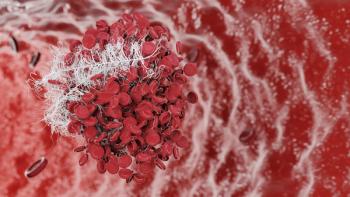
- June 2022
- Volume 88
- Issue 6
Pharmacists Can Treat Migraines With Few Adverse Effects
Options include calcitonin gene-related peptide antagonists, ergotamine, hormone therapy, lasmiditan, and triptans.
Migraine headaches are characterized by recurring episodes of pulsing or throbbing pain on 1 side of the head, often accompanied by nausea, vomiting, and/or sensitivity to light and sound.
The pain comes from the activation of nerve fibers inside the walls of the blood vessels of the meninges.1 Left untreated, or unsuccessfully treated, the pain can last from hours to days and can be moderate to severe, often becoming debilitating.1
Adults and children can suffer from migraines. Women are 3 times more likely to experience migraines than men.
Migraines typically occur in the morning upon waking. Some patients experience migraines at predictable times, such as before a menstrual cycle or at the end of a particularly stressful week. In some patients, migraines occur in stages.
Migraine Stages
Prodrome. Hours or days before a migraine, many individuals experience symptoms such as bloating, changes in appetite, constipation, diarrhea, fatigue, mood changes, and severe thirst, in addition to sensitivity to light, odors, and sound.2
Aura. Aura usually begins gradually over 5 to 25 minutes. Aura usually lasts less than an hour. These symptoms stem from the nervous system and can involve changes in smell, taste, and touch; difficulty speaking; a heavy feeling in the arms and legs; numbness on 1 side of the body; ringing in the ears; and vision changes.2
Attack. The actual migraine attack tends to get worse with physical activity and can last a few hours or several days.2
Postdrome. After a migraine attack, patients are often left feeling confused, exhausted, and weak. This can last a day or more.2,3
Causes
Migraines have a genetic component to them. Four of 5 patients with migraines have a family member who suffers the same affliction. If 1 parent has migraines, a child has a 50% chance of having them as well. That number jumps to 75% if both parents suffer from migraines.2
Having other medical conditions increases the risk of developing migraines. These include anxiety, bipolar disorder, depression, epilepsy, and sleep disorders.2
Triggers
Everyone has different triggers that may bring on a migraine. These include alcohol; chocolate; food additives, such as monosodium gluconate or nitrates; hormonal changes; medications, such as vasodilators; stress; tobacco; too little or too much caffeine; too little or too much sleep; and weather changes.2
Treatment
Although there is no cure for migraines, treatment focuses on symptoms relief and prevention of additional attacks. Some tips for nonmedical relief of symptoms may include drinking fluids; placing a cool compress or ice pack on the back of the neck, forehead, or top of head; and resting with the eyes closed in a cool, dark, quiet area.3
Lifestyle changes may help prevent migraine headaches. Some of these include logging triggers to avoid them in the future, stress management techniques, and weight loss.
However, medical intervention is often required. Usually, the sooner treatment begins after migraine onset, the better it will work.
OTC pain relievers containing acetaminophen, aspirin, caffeine, and/or ibuprofen often work well. Of course, products containing aspirin should not be given to patients younger than 19 years because of the risk of Reye syndrome.
If patients are taking these OTC pain relievers more than 2 days a week, they should be directed to see a physician, who may prescribe a product to better manage the migraines.2
Many patients experience nausea and sometimes vomiting with migraines. Physicians will often prescribe medication to control nausea, such as metoclopramide, ondansetron, or promethazine, to help resolve this symptom.2
Triptans are FDA-approved, first-line agents used to treat migraines.
Triptans reverse the vasodilation that causes migraines by selectively binding to the vascular serotonin receptor 5-HT1B. They also selectively bind to the neurogenic and central serotonin 5-HT1D receptors, thus inhibiting activation of the trigeminal nerves. This also results in blockage of the transmission of pain signals to the brain.4
Triptans are available in multiple dosage forms, including nasal sprays, oral tablets, orally disintegrating tablets, and subcutaneously injectable products.4
Triptans may cause coronary vasoconstriction, dizziness, and nausea as well as a group of adverse effects (AEs) called “triptan sensations” that include chest tightness, flushing, neck pain, paresthesia, and tingling.4
Ergotamine is also used to treat migraines by selectively binding to and activating serotonin receptor 5-HT1D, and they act similarly to triptans. Ergotamine also binds to alpha-adrenergic receptors, stimulating vascular smooth muscle, resulting in vasoconstriction.5
Adverse reactions to ergotamine are numerous and range from relatively benign symptoms such as dizziness, drowsiness, and xerostomia to severe symptoms including arrhythmias and decreased blood flow.5 Therefore, ergotamine derivatives have fallen out of favor as first-line migraine treatments.
Lasmiditan is the first FDA-approved “ditan” used to treat migraines. Lasmiditan has a strong affinity to bind to serotonin receptors 5-HT1F, which are involved in pain signaling. These receptors are located both centrally and peripherally. Unfortunately, the mechanism of action of ditans are not clearly understood.6
Adverse reactions to lasmiditan include central nervous system depression, driving impairment, headaches related to overuse, and serotonin syndrome.6
Calcitonin gene-related peptide (CGRP) antagonists block the effects of CGRP, a small protein located in the trigeminal nerve.
This blockage results in inhibition of neurogenic inflammation, inhibition of pain signals, and inhibition of vasodilation without causing vasoconstriction.7,8
The most common AEs of CGRP antagonists include constipation and injection site reactions. Less commonly, these medications may cause new or worsening constipation and hypertension with serious complications.7
Hormone therapy can be used for patients who suffer from migraines around their menstrual cycle.
Additional forms of treatment for consideration include acupressure, acupuncture, biofeedback, chiropractic care, cognitive behavioral therapy, craniosacral therapy, and massage.2
Because each individual’s migraines are different, it stands to reason that not every available medication works in every case. Pharmacists can help patients determine which medications might work for them and educate them about how the medications work and their possible AEs.
About The Author
Kathleen Kenny, PharmD, RPh, has more than 25 years of experience as a community pharmacist. She is a freelance clinical medical writer based in Homosassa, Florida.
Reference
1. Headache: hope through research. National Institute of Neurological Disorders and Stroke. Updated April 18, 2022. Accessed May 11, 2022. https://www.ninds.nih.gov/health-information/patient-caregiver-education/hope-through-research/headache-hope-through-research
2. Migraine. Mayo Clinic. July 2, 2021. Accessed June 1, 2022. https://www.mayoclinic.org/diseases-conditions/migraine-headache/symptoms-causes/syc-20360201
3. Migraine. Medline Plus. Accessed May 11, 2022. Updated May 5, 2021. https://medlineplus.gov/migraine.html
4. Triptans. National Library of Medicine. October 30, 2021. Accessed May 12, 2022. https://www.ncbi.nlm.nih.gov/books/ NBK554507/
5. Ergotamine. National Library of Medicine. May 6, 2022. Accessed May 12, 2022. https://pubchem.ncbi.nlm.nih.gov/ compound/ERGOTAMINE
6. Reyvow. Accessed May 12, 2022. https://www.reyvow.com/
7. Nurtec. Accessed May 12, 2022. https://www.nurtec-hcp.com/rimegepant.
8. Aimovig. Prescribing information. Amgen; 2021. Accessed May 12, 2022. https://www.pi.amgen.com/-/media/Project/Amgen/Repository/pi-amgen-com/aimovig/aimovig_pi_hcp_ english.ashx
Articles in this issue
over 3 years ago
Case Studies: June 2022over 3 years ago
Pet Peeves: June 2022over 3 years ago
COVID-19 Affects Development of Medical Devicesover 3 years ago
Rx Product News: June 2022over 3 years ago
Case Studies: Postvaccine Careover 3 years ago
Opdualag From Bristol Myers Squibbover 3 years ago
OTC Product News: June 2022over 3 years ago
Assisting Older Adults With Medication Use Can Reduce Errorsover 3 years ago
Shine a Light on Diabetes and Mental HealthNewsletter
Stay informed on drug updates, treatment guidelines, and pharmacy practice trends—subscribe to Pharmacy Times for weekly clinical insights.










































































































































































































